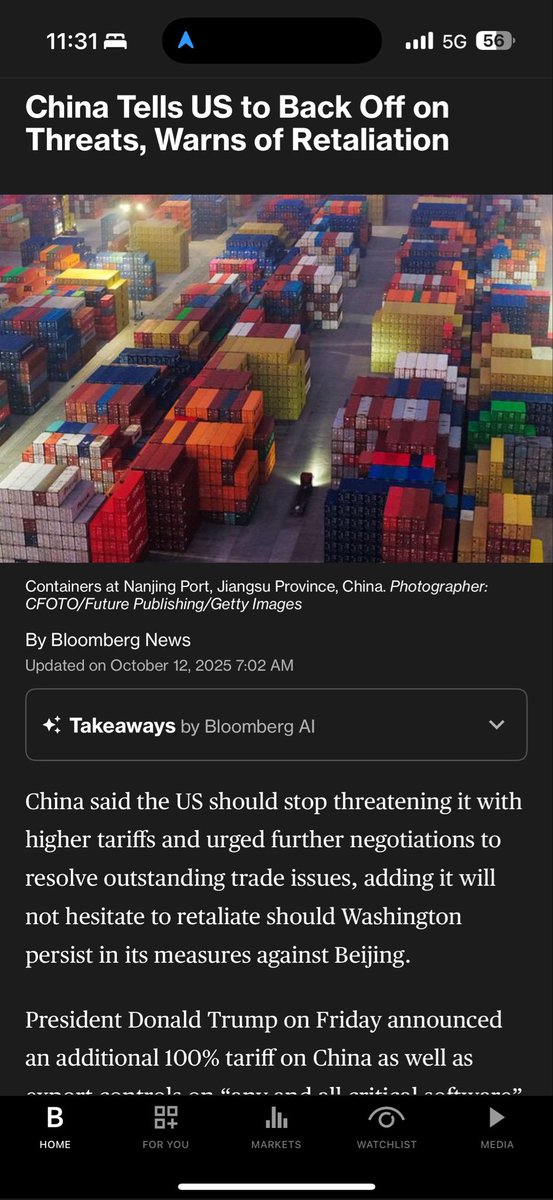The $2.5 Trillion Misunderstanding That Shook Global Markets
A massive market sell-off, including a historic crypto liquidation, appears to have been driven by a simple misinterpretation of a Chinese policy announcement. Here's a breakdown of what happened and what it means for investors.

Last week, global markets went into a freefall, erasing a staggering $2.5 trillion in value from the S&P 500 alone—equivalent to over ₹220 lakh crore. The sell-off triggered the largest crypto liquidation event in history. The cause? It appears to be one of the most expensive misunderstandings the financial world has ever seen.
Let’s unpack the timeline, as the sequence of events is crucial to understanding the panic.
The Anatomy of a Panic
On October 9th, around 8:30 am ET, China announced new “export controls” on rare earth materials. Rare earths are critical components in everything from smartphones to advanced military hardware. China dominates over 80% of the global processing capacity for these materials, so any restriction is significant news.
But for the next 26 hours, the market barely reacted. It was treated as a non-event.
Then, on October 10th, the US President posted on social media about the issue, threatening a sweeping 100% tariff on all Chinese goods in response. That was the spark. The market immediately priced in a full-blown trade war escalation, and the sell-off began in earnest across global indices, from New York to Mumbai.

Late last night, however, Beijing released a statement clarifying its position. The new controls are not a full export ban. The statement clarified that applications that “meet regulations” will be approved. This completely changes the calculus. The initial announcement, which sat dormant for over a day, was likely misinterpreted under the pressure of a single social media post.
The prevailing analysis on Friday, amid the downturn, was that the 100% tariff threat was a bargaining chip. After China’s clarification, the odds of those tariffs ever being implemented seem extremely low. It appears a multi-trillion-dollar market crash was triggered by a delayed reaction to a misread headline.
Three Ways to Interpret the Chaos
While a “misunderstanding” is the simplest explanation, it reveals deeper, more unsettling truths about our modern markets. There are a few ways to look at this.
1. The System is Dangerously Fragile
The most obvious takeaway is that markets have evolved into their most reactionary form in history. We live in an age where a single social media post can erase trillions of dollars in value faster than any analyst can publish a research note. Fundamentals take a backseat to sentiment, and sentiment is now driven by a 24/7 news and social media cycle.
The system’s core risk is no longer just about earnings or interest rates; it’s about headline velocity. As one observer put it, the market is essentially “one big group chat,” where vibes can overpower facts.

2. It Was Calculated, Not Confused
A more cynical view is that this was no accident. In geopolitics, there are rarely simple misunderstandings. Some argue that China intentionally uses “strategic ambiguity.” They release a vaguely threatening policy, gauge the global reaction, and then “clarify” their position to soften the blow if the response is too strong. It’s a way of testing boundaries without committing to a full-scale confrontation.
Others point the finger at market manipulation. The sequence of events—a threat, a market crash, and a convenient walk-back—creates immense volatility. And where there’s volatility, there’s an opportunity for well-positioned traders to make a fortune. The idea that this was a “controlled demolition” to shake out leveraged positions and allow large investors to accumulate assets at a discount is a pervasive one.

3. The Market Was a Powder Keg Looking for a Match
A third perspective is that the market was already over-leveraged and ripe for a correction. The tariff news wasn’t the fundamental cause of the crash but merely the trigger. Excessive margin and leverage, particularly in the crypto markets, created a fragile structure where any significant shock would have caused a cascade of liquidations.
In this view, the “misunderstanding” simply provided the necessary excuse for a much-needed deleveraging event. It flushed out weak hands and reset the market.
What Now? The Path Forward for Investors
Regardless of the true cause, the landscape has shifted. With China clarifying its stance and de-escalating the rhetoric, the path may now be clearer for a new “trade deal.” We should not be surprised to see positive headlines emerge in the coming days and weeks.
For investors, this chaotic episode offers a few critical lessons:

- Risk Management is Everything: In a market that can turn on a dime based on a single tweet, hedging your portfolio is not optional. Your investments should be structured to withstand sudden, unpredictable shocks.
- Don’t React to the Noise: The first reaction is often the wrong one. The investors who panic-sold into the crash are now facing a potential sharp rebound, as sidelined capital is always eager to re-enter after a purge.
- Understand the Real Leverage: While the tariff drama played out, the underlying reality remains: China holds significant leverage through its control of critical supply chains like rare earths. A trade deal won’t solve this dependency. That is the long-term strategic issue to watch.
The dust is still settling, but we may have just witnessed a multi-trillion-dollar lesson in the fragility of modern markets. The rebound could be just as dramatic as the fall. Position your portfolio accordingly.
Test Your Knowledge

Open a Demat Account
Looking to start your investment journey? Open a demat account with Upstox, one of India's leading discount brokers with powerful tools, low brokerage, and seamless trading experience.
Open Your Account Today
Open an AccountDisclaimer: I am an authorized person (AP2513032321) with Upstox.
Investments in the securities market are subject to market risks, read all the related documents carefully before investing.
About Vipin
Vipin is a contributor to FinHux.
Related Articles

Geopolitical Shockwave: Sensex, Nifty Tumble After US Action in Iran
Indian markets plunged following reports of US military action in Iran, triggering a sharp sell-off. The Sensex and Nifty fell on fears of a wider conflict and rising oil prices, with defence stocks bucking the trend. Investor caution is paramount as regional instability dictates market direction.

RBI Holds Repo Rate, Sparking 700+ Point Rally in Sensex & Nifty
The Indian stock market snapped its eight-day losing streak with a spectacular rally after the Reserve Bank of India (RBI) kept the repo rate unchanged at 5.5%, boosting investor confidence with an upgraded growth forecast.

Sensex Surges 676 Points on GST Reform Hopes & S&P Rating Upgrade
The Indian stock market rallied spectacularly, with the Sensex and Nifty posting significant gains. We analyse the two primary catalysts—hints of major GST reform and a sovereign rating upgrade by S&P—and explore their implications for investors.
